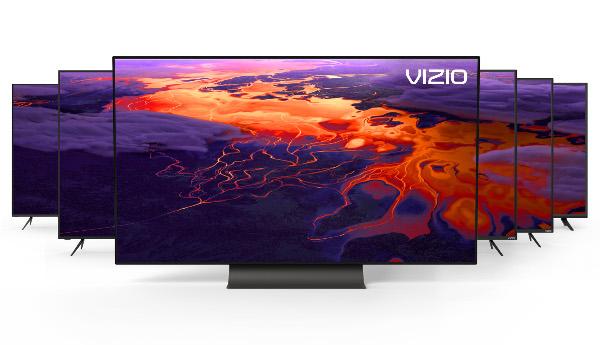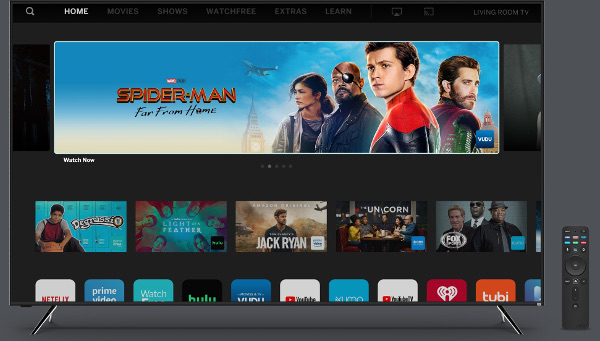Vizio Unveils OLED, Readies Bigger, Brighter LCD TVs

Vizio introduced its first OLED TVs at CES while bolstering its 4K LCD TV lineup by raising full-screen brightness, launching its first 85-inch model, and bringing select HDMI 2.1 functions to 4K TVs for the first time, including eARC, auto low latency mode (ALLM) to quick-response video gaming, variable refresh rate (VRR) for smooth gaming and, in the OLED series and top LCD series, the ability to deliver 4K frame rates up to 120fps.
Vizio will also bring the UHD Alliance’s Filmmaker Mode to all 4K TVs, and the company is expanding the use of Samsung-developed HDR 10+ dynamic HDR, which appears in all 4K models in 2020 and joins dynamic Dolby Vision HDR as well as HDR 10 and HLG. HDR10+ was added as a software update in late 2019 to select Vizio 2019 and 2018 TVs...
...Before the show, Vizio didn’t say how many OLED TVs it would launch later this year, but the company did say its OLEDs would feature HDMI 2.1 features such as 4K/120Hz passthrough, variable refresh rate (VRR) and AMD’s FreeSync for smoother game play, a “borderless” design, a 4mm (0.16-inch) profile, and OLED’s advantages, including deep blacks and wide viewing angle...
Details of the company’s OLED launch were unavailable, but the company will join LG and Sony in selling OLED TVs in the U.S.
Here’s what else Vizio is talking up in TVs at CES:
Full-Screen Brightness: All quantum-dot LCD TVs get a full-screen brightness boost to enhance HDR performance, with “the most significant improvements” appearing in the M8, P9, and PX series, a spokesman said. Full-screen brightness goes to 800 nits in the PX series, 600 nits in the P9 series, 500 in the M8 series, and 350 in the M7 series. Last year’s full-screen brightness specs were unavailable.
“With the rapid increase of HDR content availability in the marketplace, full-screen brightness becomes a more important factor,” a spokesperson said.
Peak brightness, critical to HDR performance, also got a boost in the M8 series (to 800 nits from 600) and in the M7 series (to 600 from 400). The PX series continues to max out at 3,000 peak nits, and the P9 series continues to max out at 1,200 peak nits.
Size: The company unveiled its first 85-inch LCD TV, appearing in the flagship three-model P Series Quantum X series, and it continues to offer a trio of 75-inch TVs, one each in the PX, P9, and V5 series. The latter series also continues to offer a 70-inch screen.
Contrast: In the three-model flagship PX series, the number of contrast-enhancing back-lit local dimming zones goes up to 792 in the 85-inch screen size, up from a maximum 480 in the 2019 series’ 75-inch model and 384 in the 65-inch model. In 2020, the PX series retains the 75- and 65-inch sizes, but information was unavailable on their zone counts.
Like last year, the M8 series continues to max out at 90 zones, but the M7 series gets a slight upgrade to a maximum 30 zones from 20. The V5 series offers full-array LED lighting without local dimming.
Color gamut: Vizio continues to max out at 85% of the Rec. 2020 standard in 4K LCD TVs, with the number of models meeting that level growing from two SKUs in 2019 to three with the expansion of the PX series. P9 series coverage is close to 83% of Rec. 2020, with M series at around 80%, a spokesman said.
For reference, 100% of the widely quoted P3 standard equals about 73% of the Rec. 2020 standard.
HDMI 2.1: All 4K models get select HDMI 2.1 features, including eARC, ALLM, VRR and, in the PX and P9 series and OLED series, the ability to display 4K content at up to 120fps...
...Gaming Features: All quantum-dot models will feature a host of gaming-performance features dubbed ProGaming Engine. The features include variable refresh rate (VRR) to sync the TV’s refresh rate to the video game’s frame rate for smoother game play, AMD FreeSync VRR technology for use with computers and games incorporating FreeSync, and less-than 15ms input lag for quick response to commands. Vizio also developed an HDR tone-mapping curve exclusively for games to deliver a “more expansive dynamic range,” a spokesperson said.
The non-quantum-Dot V series features VRR and ALLM...

...ATSC 3.0: The company also said it is still “evaluating the right time” to include ATSC 3.0 (Next Gen TV) over-the-air TV tuners in its TVs, contending that it is meeting with TV broadcasters to learn about their ATSC 3.0 plans and pointing out the costs of implementation. Vizio has “to look at overall value” in adding features, said John Hwang, VP of hardware product management.
ATSC 3.0 broadcasts will support 1080p and 4K video resolutions (up from the current 720p and 1080i), 10-bit versus 8-bit video, HDR, wide color gamut (WCG), frame rates up to 120Hz from 60Hz, object-based 3D surround sound with up to 7.2.4 channels, and — because the standard is based on the Internet Protocol — interactive and personalized content, including interactive advertising.
https://www.soundandvision.com/content/vizio-unveils-oled-readies-bigger-brighter-lcd-tvsits cool to know vizio is launching oled tvs this year beside lg and sony. not only that but all of vizio oled tvs and some led-lcd tvs will have hdmi 2.1 supports which features allm, vrr, and 4k120. very nice. not to mention that its oled tvs also support amd freesync too.
while vizio non-oled led-lcd tv top of the line quantum px series can get as bright as 800 nits for the whole entire screen and up to 3,000 nits of brightness for part of its screen. that is very, very bright. very nice.

if i remember correctly, last year's model peak's brightness is only around 2,500 nits for part of its screen and this year, they up the total brightness to 3,000 which is a 500 nits increase. cool.

while step down model p series have a maximum full screen brightness of 600 nits and part of it screen up to 1,200 nits which is still very cool. another step down model, the m8 series has a maximum brightness of 500 nits for full screen and 800 nits for part of it screen. the step down model after that, the m7 has a maximum of 350 nits of full screen brightness and a maximum 600 nits for part of it screen. which are very nice.

For the px led-lcd series, it can produce color up to 85% of Rec 2020 standard, while the regular p series can produce up to 83% and m series only around 80%. That is still very impressive comparing to p3 standard color space which only cover around 73% of rec 2020 standard.